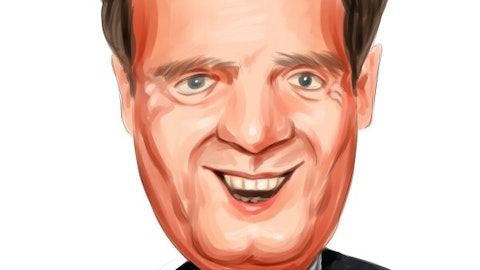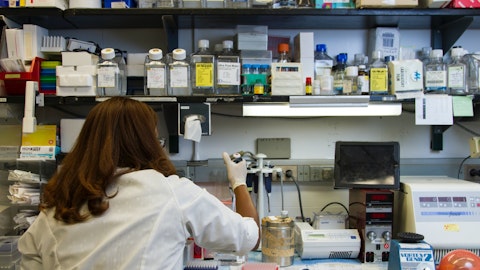Reza Zadno: Thanks, Josh. I’m not providing financial guidance, but as I summarized in my previous remarks, we feel very good about the business going forward, and every metric is moving in the right direction. These are the tailwinds that have a strong pipeline. We saw the increased utilization. United coming on board, down 95% access to this therapy among patients. We demonstrated also a prudent cost control, and with the recent financing, we strengthened our balance sheet combination of these rules. They cost profitability. I also want to mention that we are very early still in this round, whether it’s on utilization or robot placement. These are all those parameters that gives us confidence going to 2024. Kevin, do you want to?
Kevin Waters: Yes, Josh. I mean, the drivers specifically that you referenced. At the end of the day, our business is fairly simple. We sell capital, and the capital is used through what we measure as utilization. Those drivers don’t change. In 2024, I do think you see a business, though, that shifts more heavily weighted, obviously, to disposable as we grow our install base. That’s point one. Point two, we’re obviously aware of the management team. It has a company, the street expectations. If you look at utilization expected of the company in 2024, it’s roughly equivalent to what we’re guiding to in Q4 of 2023, which I would suggest is a proof point that what expectations are not terribly ahead of even where we’re at today.
That’s point one on utilization. Then point two, we still believe our ability to sell capital is directly correlated to the number of capital reps that we have in the field that are productive. We’re going to exit the year probably close to the 35 to 40 range of capital reps, which we think if you just take average productivity, I mean, you could do the math yourself and back into kind of what a system number would look like for 2024. But to Reza’s comment, we’re very early in our penetration, and therefore, we don’t expect diminishing returns as we have capital reps. So I appreciate we’re not answering your question directly on 2024, but as Reza mentioned, the growth drivers of the business are in place to allow this business to continue to grow at, I’d say, rates that far exceed most other med device companies.
Joshua Jennings: Now that was very helpful. Thank you. And just to follow up, as you’re seeing the AQUABEAM system, the AQUABEAM relational treatment being adopted at centers and deeply penetrating those accounts, becoming standard-of-care at those centers, I was just hoping to get a feel for what’s being displaced. Is there a low-hanging fruit in the Resective either approach or technology bucket? TURP, HoLEP, Greenlight Prostatec [Ph], MERS, really broad-based, I guess, replacement of those approaches. I really wanted to ask that and just hear also about just the conversion of HoLEP surgeons and that rate to date in the United States. Thanks for taking the questions.
Reza Zadno: Thanks, Josh. So when we ask this question from our surgeons, definitely TURP and Greenlight are the ones that we ask them if you didn’t use our technology, what else you could use. The majority of the cases are from TURP and Greenlight. And that’s because TURP, again, with the data we have still, it was the largest Resective treatment. And as far as the larger prostate, we definitely, we are, physicians use our product for larger prostate. The advantage compared to other therapies is the shorter therapy time, faster recovery, and also not that much dependent on surgeon skill. So these are definitely for larger prostate, the advantage we have is in those areas.
Kevin Waters: I’d also just add specific to your question on HoLEP. I mean, if you look at the Resective market, Josh, HoLEP is about 10% of the Resective surgical market, maybe something slightly less of that. And the reality of that procedure, it’s a very long procedure. It’s difficult to perform. It’s highly specialized. I don’t think anybody would suggest that HoLEP would have the ability to become the standard-of-care over time. So as Reza mentioned, it primarily is TURP and Greenlight. I’m sure we’re getting some HoLEP cases, but there’s also, I would say many HoLEP loyalists that our growth is not dependent on cannibalizing in the near term.
Joshua Jennings: Great. Thanks again.
Operator: Thank you. One moment please for our next question. Our next question will come from Matthew O’Brien with Piper Sandler. Your line is open.
Matthew O’Brien: Afternoon. Thanks for taking my questions. And I’ll refrain from trying to make a joke about the smoke alarm going off because your business is on fire.
Reza Zadno: We appreciate it.
Kevin Waters: First call in the new facility here, but it was interesting. We’re good.
Matthew O’Brien: Got it. So on the utilization side, I’m just curious about the performance there because, again, in Q4, we’re expecting a pretty big step up as far as utilization goes for the existing systems. You grew 5% sequentially in what’s typically a seasonally slow quarter. So can you just talk about some of the momentum you’re seeing? And again, kind of the Craig’s question, across the cohorts are some of the people that have been using you for a while at 10 cases per month on average. And then, what kind of benefit are you baking in for United in Q4 specifically?
Kevin Waters: Yes. So I think all of your questions point to kind of our comfort around our ability to expand utilization in the fourth quarter. Right. I mean, that’s really what it comes down to. And our Q4 guidance implies utilization of about six and three quarters, 6.8 procedures per month per account in the fourth quarter. And when you look at that metric regarding cohorts, so to achieve that in the fourth quarter, we do not need any accounts that purchase systems in 2023 to be at that corporate level. And that means by definition that the accounts that have been with us prior to 2023 are doing north of 6.8. And in many cases, as you pointed out, well north of 6.8. And that is what is expanding utilization in the fourth quarter.



